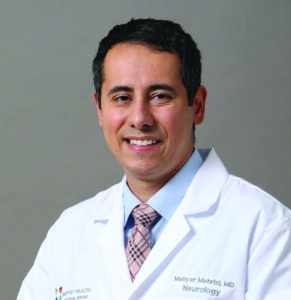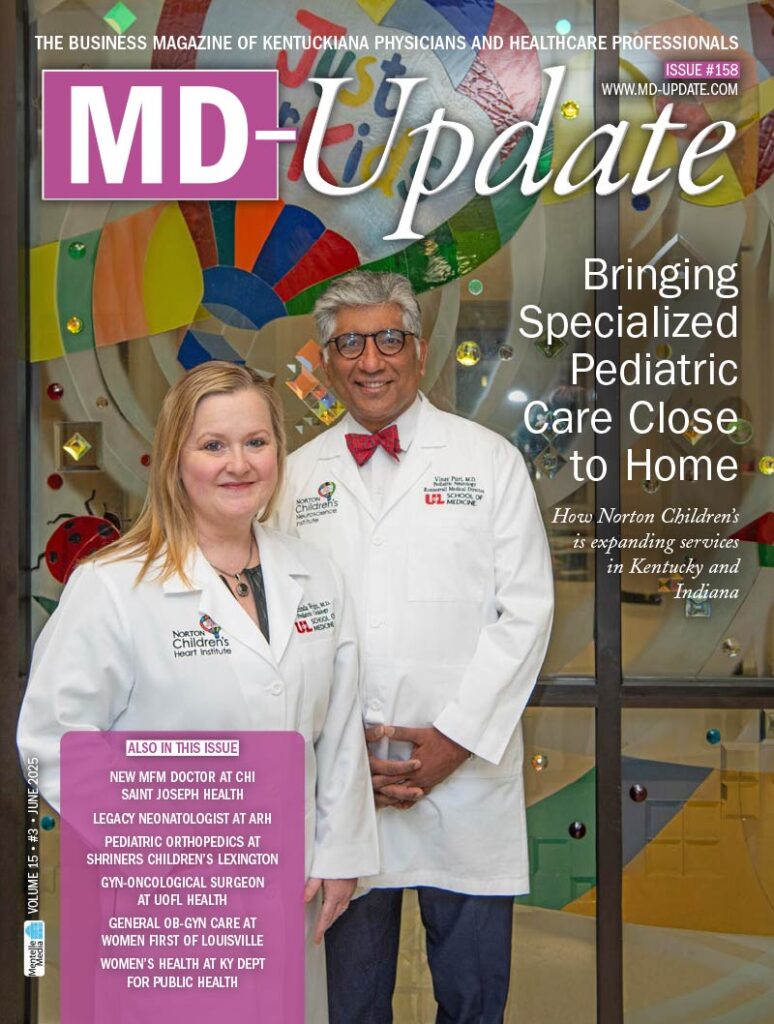
LOUISVILLE Every doctor has had an unusual case, right? A good story to tell. Mehyar Mehrizi, MD, FAAN, neurologist at Baptist Health Medical Group Neurology in Louisville has one that he tells to his neurology students at the UofL School of Medicine.
He was doing his subspecialty fellowship training in clinical neurophysiology in epilepsy at Indiana University Methodist Hospital when a well-spoken, middle-aged man sat down and said, “Doctor, you’re my last hope of finding out what’s wrong with me.”
The patient related how for the past two to three years he had been having sudden, uncontrollable episodes where he would throw things, scream profanities and yet not remember a thing about them. His wife was close to divorcing him because they couldn’t go out in public, not even church. “I’d start yelling out curse words in church during the sermon,” said the patient.
In the midst of the lengthy interview, with Mehrizi totally perplexed, they decided to order lunch from the hospital cafeteria. During the phone call to the cafeteria, the patient started yelling profanities and throwing the phone. Fortunately, he was hooked up to Mehrizi’s EEG. The patient’s brain activity spiked. Mehrizi saw a frontal lobe seizure on full display. Within 20 seconds, the seizure passed. Then the patient said, “Doctor, I’m hungry, can we get lunch?” He had no memory of the previous five minutes.
A Neurologist at an Early Age
Mehrizi became intrigued by human physiology during seventh grade at Morton Middle School in Lexington, Kentucky. He credits his biology teacher, Mrs. Jacobs, for sparking his interest. That led to science classes at Henry Clay High School, followed by his B.S. in neuroscience with honors from the University of California at Berkeley. There he studied under neuroanatomist Jeffery Winer, PhD, and then pediatric neurologist Elliott Sherr, MD, PhD, at UC San Francisco.
“I’m such a social creature and enjoy interaction with people. I chose to pursue a medical degree so I could work with people and not just lab mice.”— Mehyar Mehrizi, MD
“I could have stayed in clinical research. I like research because on a grander scale your work will stay in the historical, scientific record and benefit many people, other doctors and their patients. I continue to do research with my students at UofL School of Medicine and will publish another paper soon on a case presentation on trigeminal neuralgia,” says Mehrizi.
He continues, “But I’m such a social creature and enjoy interaction with people. I chose to pursue a medical degree so I could work with people and not just lab mice.”
After Berkeley and UCSF, Mehrizi returned to Lexington to attend the University of Kentucky College of Medicine, graduating in 2009 as class president. Working with Bill Robertson, MD, at UK confirmed his decision to pursue neurology, says Mehrizi. Following medical school, he pursued a neurology residency at Indiana University School of Medicine followed by a subspecialty clinical neurophysiology fellowship, completed in 2014.
Mehrizi is currently teaching medical students and serves as an adjunct clinical associate professor of neurology at Indiana University School of Medicine and is a member of the gratis clinical faculty at University of Louisville School of Medicine Department of Neurology. He is also a fellow of the American Academy of Neurology.
His medical practice consists of a diverse patient population, ages 18 to 96, from all different demographics and backgrounds. They present with different neurological disorders such as migraines, epilepsy, stroke, trigeminal neuralgia, essential tremors, and dementia.
Neurophysiology and Seizures
Mehrizi says he was drawn to neurophysiology with epilepsy and migraines. “These are the two specific neurological disorders and conditions where I feel that I can improve the quality of life for my patients the most and make the most positive impact in terms of patient care and feel most comfortable treating based on my training.”
Neurophysiology is a broad combination of several medical disciplines. It includes testing nerve pathways using electroencephalography (EEG) and electromyography (EMG). It also includes somatosensory, auditory, and visual evoked potential, testing the pathways of nerve stimulation, sending small shock waves throughout the nervous system to determine if the stimulus is captured by the brain. This can determine if there are lesions in the nervous system, blocking the impulses to the brain.
Neurophysiology also includes sleep medicine and surgical neurophysiology monitoring during brain surgery.
“The biggest question that I have yet to answer is: ‘What role does the brain play in consciousness? What is it about the human brain that allows us to have thoughts, to analyze, to make decisions?” says Mehrizi.
He continues, “The brain controls the rest of the systems that keep us alive: the nervous system, the skeleton and muscles, the cardiovascular system, the digestive system. When there’s a seizure and the brain malfunctions, all these other systems have a reaction. That’s how I first became interested in epilepsy and seizures.”
Are Epilepsy and Migraines Increasing?
The study of epilepsy goes back to ancient Egypt when holes were drilled into the head to release blood believed to contain the evil spirits that were thought to have possessed the epileptic person.
It’s hard to tell if epilepsy and migraines are increasing in the U.S. population, says Mehrizi, but there’s no doubt that reports of both are on the uptick, possibly because they are being diagnosed more. The medical knowledge of epilepsy has increased dramatically in the last 100 years and much more so in the last 10 to 20 years.
Mehrizi cites an example called “absence seizure,” typically in a teenager who seems “out of it,” just staring into space during school. This teenager can be misdiagnosed with ADD or ADHD and becomes an underperforming student when he’s really having multiple little absence seizures throughout the day. Undiagnosed, this can eventually lead to adult grand mal seizures. Primary generalized epilepsy, the category for absence seizures, responds very well to medical treatment, says Mehrizi. “But this is an example of the need for increased awareness and diagnosis of epilepsy.”
There is a genetic component to epilepsies, specifically generalized epilepsy and certain focal epilepsy caused by tuberous sclerosis. Stroke is the most common reason for new onset of focal epilepsy in patients over the age of 50 years old. Head trauma, brain infections, and intracranial hemorrhage can also lead to focal epilepsies.
“For patients with migraines and epilepsy there are plenty of options that can be near curative and for some, completely curative.”— Mehyar Mehrizi, MD
There are many more triggers for migraines than in earlier generations, such as dietary ingredients, like MSG, artificial sweeteners, dark chocolate, and spicy foods. In addition, a lack of exercise and activity, stress, and computer screen time can contribute to migraine onset.
Advancements in Epilepsy and Migraine Treatment
In the treatment of epilepsy specifically, there have been advancements in devices such as the vagal nerve stimulator (VNS), which Mehrizi uses frequently. The VNS is placed under the skin on the chest, and a wire is wrapped around the vagus nerve.
A new modification in the VNS has a cardiac monitor because research shows that when someone is having a seizure there’s a spike in the heart rate. The VNS sends a nerve stimulus to the brain to modify the length, frequency, and severity of the seizure.
The responsive neurostimulator (RNS) is a newer device than the VNS. It records live electrical activity in the brain. Again, the purpose is to send a small electrical shock to the brain to either prevent the seizure or decrease the length and severity of it when detected.
DBS, deep brain stimulators, along with neurosurgical procedures can assist with treatment of medically refractory epilepsy. There is also epileptic surgery, where neurosurgeons remove epileptogenic portions of the brain that are causing the seizures. There are also newer pharmaceutical medications such as Xcopri which can also assist with treatment of epilepsy along with a multitude of other FDA approved medications.
In treatment of migraines, there are newer anti-CGRP medications which are safe and very effective. Mehrizi performs Botox injections and occipital nerve blocks for further assistance with migraines and occipital neuralgia.
Epilepsy and Migraines are Treatable
Mehrizi says that the most common misconception is that neurological disorders are not treatable. “When we think of stroke, presenting outside of IV tPA or thrombectomy window, or dementia or Parkinson’s disease, we may not be able to cure the patient of these neurological disorders. But for patients with migraines and epilepsy there are plenty of options that can be near curative and for some, completely curative.”
“My personal philosophy of care is based on mutual respect between patient and physician,” says Mehrizi. “Baptist Health provides me the essential time needed to see my patients and care for them effectively and appropriately without feeling like we are rushed. I tell my patients we will have enough time to answer their questions, and they feel like they have been appropriately heard and leave my office with an understanding of their plan of care and what to expect for the future.”




